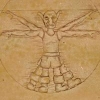The vertex processing is fairly expensive.
The relation between number of vertices and number of faces doesnt really matter a lot, only the number of final vertices count. With final vertex I mean after splitting vertices accordingly to UV, color, normals, tangentspace etc, which can't be easily estimated in a modelling tool.The relation of vertices to faces depends more on the model topology, material variance etc. A simple sphere has an other factor than a tree with leafs.
But to be honest, no artist would try to model his model to reduce the number of shared vertices in a significant way, thought they will try to optimize when possible. And having 1.2 vertices for each tri, with an worst case of 3, sounds neither bad nor good.
What would you think is a good scene average?
What is a good value for a character mesh?
What is a good value for a props mesh?
You can't really tell.
There are lot of factors which count more than the number of vertices. Eg most modern videocards will be able to render props with 500-1000 vertices faster than you can feed the rendering API, but this will change completely once the engine use batching, instancing or a modern API (with less overhead). On last gen hardware cars in car racing games had sometimes more than 60k vertices, characters 10k , a zombie in L4D2 ~2k (?). Is your model animated ? How many bones are used ? How many materials ? How many textures ?
Some hints:
1. If you work in a project context, you will be told what are the limits and requirements.
2. If you want to create some game art to show off, it is more important to show good skills and creativity, a good use of texture space, a sparse use of bones, a good mesh topology, avoidance of unnecessary surfaces etc.
3. If you want to write your own game and want to pin down your art requirements, then you need to create an (technical) art concept in the first place. How will the environment look like ? Which art style will be used ? Which target platform ? What about the dynamic part of the scenen (4 moving characters vs. 100 zombies) ? What will be the camera perspective ? Do you need higher quality models for cut-scenes ? Do a lot of prototyping,









